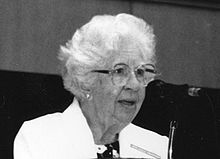Eleanor J. Gibson
| Eleanor Jack Gibson | |
|---|---|

Eleanor Gibson - Keynote Address - 1993 APS Convention
|
|
| Born |
December 7, 1910 Peoria, Illinois |
| Died | December 30, 2002 (aged 92) Columbia, South Carolina |
| Fields | psychology |
| Institutions | Cornell University |
| Alma mater |
Smith College (B.A., 1931) (M.S., 1933) Yale University (Ph.D., 1938) |
| Doctoral advisor | Clark L. Hull |
| Known for | Visual Cliff, Differentiation and Enrichment of Embedded Structures |
| Influences | James J. Gibson |
| Notable awards | National Medal of Science (1992) |
Eleanor Jack Gibson (7 December 1910 – 30 December 2002) was an American psychologist who focused on reading development and perceptual learning in infants and toddlers. In the 1960s and 1970s Gibson, with her husband James J. Gibson, created the Gibsonian ecological theory of development which emphasized how important perception was because it allows humans to adapt to their environments. Perhaps her most well-known contribution to psychology was the "visual cliff", which studied depth perception and visual or motor impairments in both human and animal species. This led to a new understanding of perceptual development in infants. The environment provides information for the sensory system to develop with increased stimuli, so perceptual development corresponds with environmental stimuli. Infants develop from adapting to the environment. Gibson was elected to the National Academy of Sciences in 1971 and as a fellow of the American Academy of Arts and Sciences in 1977. In 1992 she was awarded the National Medal of Science, which is the highest scientific honor in the United States, and only five of which have been awarded to psychologists.
Eleanor J. Gibson was born in Peoria, Illinois on December 7, 1910. While much of her early life is unknown, Gibson received her B.A. degree in 1931 and her M.S. degree in 1933 from Smith College in Massachusetts. While studying at Smith College Gibson met James J. Gibson, a professor there whom she married in 1932. In 1938, she completed her Ph.D. from Yale University. Once completed, Gibson returned to Smith College and began teaching. In 1941 Gibson's husband was drafted by the Air Force to make perceptual tests for some of their pilots so Gibson, her husband and their two children moved to Texas and then on to California. Throughout this time Gibson was a homemaker but returned to work at Smith College for a few years before she and her family left for Cornell University, where she was a research associate. While at Cornell she created the "Visual Cliff" alongside Richard Walk, a professor at Cornell. Gibson died on December 30, 2002.
...
Wikipedia
